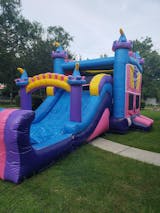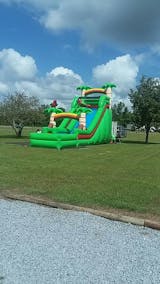
What should rental businesses do to prepare for the new season
Preparing your inflatable rental business for the new season is crucial for ensuring smooth operations, safety, and customer satisfaction. Below is a comprehensive checklist to help you get your inflatable rental business ready for the season ahead:
1. Inspect & Maintain Equipment
- Clean & Sanitize: Before any rentals, thoroughly clean each inflatable. Pay special attention to any stains, dirt, or debris, as well as ensuring they are free from mold or mildew. Use appropriate cleaners and disinfectants for vinyl surfaces.
- Inspect for Damage: Check for any punctures, tears, or wear and tear. Look for weak spots around seams, zippers, and any other high-stress areas. Patch up minor damage and get any major repairs done by a professional if necessary.
- Check Inflators & Blowers: Make sure all inflators and blowers are in good working order. Clean filters, check for any signs of wear, and test them to ensure they are functioning properly.
- Test Safety Features: Check the functionality of safety features such as netting, anchor points, and emergency exits. Make sure the inflatables are still up to safety standards.
- Storage Check: Ensure that storage bags, tie-down straps, and other accessories are intact. Store your equipment in a dry, cool place to prevent any damage from prolonged exposure to heat or moisture.
2. Inventory Check & Restocking
- Assess Stock Levels: Evaluate your current stock of inflatables (bounce houses, slides, obstacle courses, etc.) and determine if any need to be replaced or supplemented.
- Restock Accessories: Ensure that all necessary accessories like stakes, tarps, extension cords, and safety mats are in good condition and adequately stocked.
- Review Packaging: Inspect all packaging materials for damages (such as bags, boxes, or wrapping). Replace any that are ripped or damaged to maintain the professional appearance of your business.
3. Review Pricing & Packages
- Evaluate Pricing: Review your pricing structure for the upcoming season. Consider any changes in operating costs (fuel, insurance, equipment maintenance) and adjust your prices accordingly. Research your competition to ensure your rates are competitive.
- Create Package Deals: Offer bundles or package deals for multiple inflatables to encourage larger bookings. Consider discounting rentals for weekday events or early bookings.
- Deposit and Payment Policy: Review and update your rental agreement and payment policies. Ensure deposits are reasonable and that payment methods are clearly communicated to clients.
4. Prepare Vehicles & Delivery Equipment
- Vehicle Maintenance: Inspect all delivery vehicles (trucks, vans, trailers) for wear and tear. Check tires, oil, brakes, and load-bearing systems. Make sure they are capable of transporting your inflatables safely and efficiently.
- Test Delivery Equipment: Check loading equipment like dollies, ramps, and straps. Ensure they are in good working condition to make deliveries and pickups as efficient and safe as possible.
- Optimize Delivery Routes: Plan your routes to ensure timely deliveries and avoid delays. Use software or apps to optimize delivery schedules based on customer locations and traffic patterns.
5. Safety & Compliance Checks
- Regulatory Compliance: Review local laws and regulations regarding inflatable rentals. Some municipalities may have specific safety standards, zoning requirements, or permits for operating inflatable rentals. Ensure you're compliant with these regulations.
- Insurance Coverage: Verify that your insurance is up-to-date and adequately covers potential liabilities related to accidents, damage, or cancellations during events. Consider adding event-specific coverage if needed.
- Safety Training: Train staff and subcontractors on proper setup, takedown, and safety protocols. This includes ensuring that everyone knows how to handle equipment, monitor inflatables during events, and respond to emergencies (e.g., high winds, sudden weather changes).
6. Marketing & Customer Outreach
- Update Website & Social Media: Ensure your website is current, showcasing your services, pricing, and available equipment. Add clear, high-quality images and updated descriptions for each inflatable. Ensure your contact information is easy to find, and consider adding an online booking system.
- SEO & Local Listings: Optimize your website for search engines, especially for local SEO (e.g., “inflatable rentals in [City]”). Update your Google My Business profile and other local listing platforms.
- Run Promotions: Offer early booking discounts, group packages, or seasonal specials to encourage more reservations. Promote these offers via email, social media, or through paid ads.
- Engage on Social Media: Actively engage with your customers on platforms like Instagram, Facebook, and TikTok by sharing customer testimonials, event photos, behind-the-scenes looks, and promotions. User-generated content is great for building trust.
- Email Marketing: Send newsletters to previous clients and potential customers, reminding them that the season is starting. Include promotional offers, updates to your inventory, or new services (like water slides or interactive inflatables).
7. Optimize Booking & Payment Systems
- Online Booking System: Ensure your booking system is user-friendly and functioning properly. A seamless booking process will encourage more customers to book online. If you don’t have an online booking system, consider integrating one with your website.
- Payment Processing: Make sure your payment system is secure and accepts a variety of payment methods (credit cards, PayPal, etc.). Offer convenient options for customers to pay deposits or full amounts online.
- Rental Agreement Updates: Review and update your rental agreements, clearly outlining your policies on cancellations, damages, safety, and weather-related issues. Use digital signatures for a streamlined process.
8. Staffing & Operations
- Hire & Train Staff: As your busy season approaches, hire seasonal workers for deliveries, setup, and customer service. Ensure your team is fully trained in safety protocols, setup procedures, and customer service best practices.
- Create a Schedule: Plan staff schedules to handle peak times like weekends, holidays, and school breaks. Prepare for flexibility in case of last-minute bookings or weather-related changes.
- Operational Efficiency: Streamline internal processes (such as inventory management, billing, and scheduling) to ensure everything runs smoothly. Using software for scheduling and tracking can help you keep organized.
9. Weather & Contingency Planning
- Weather Protocol: Have a plan in place for dealing with weather-related cancellations or issues (such as high winds, rain, or heat). Make sure customers are aware of the weather policies and have clear guidelines for rescheduling or refunds.
- Backup Equipment: Keep spare parts on hand for quick fixes, such as replacement blowers or patches for minor damage. Consider having a backup inflatable or two to replace faulty units.
10. Customer Service & Reviews
- Customer Communication: Stay proactive in communicating with customers before, during, and after their event. Confirm bookings, remind them of delivery times, and follow up to ensure they had a positive experience.
- Collect Feedback: After each event, encourage customers to leave reviews and testimonials on your website, Google, and social media platforms. Positive reviews can build your reputation and help drive future business.




















